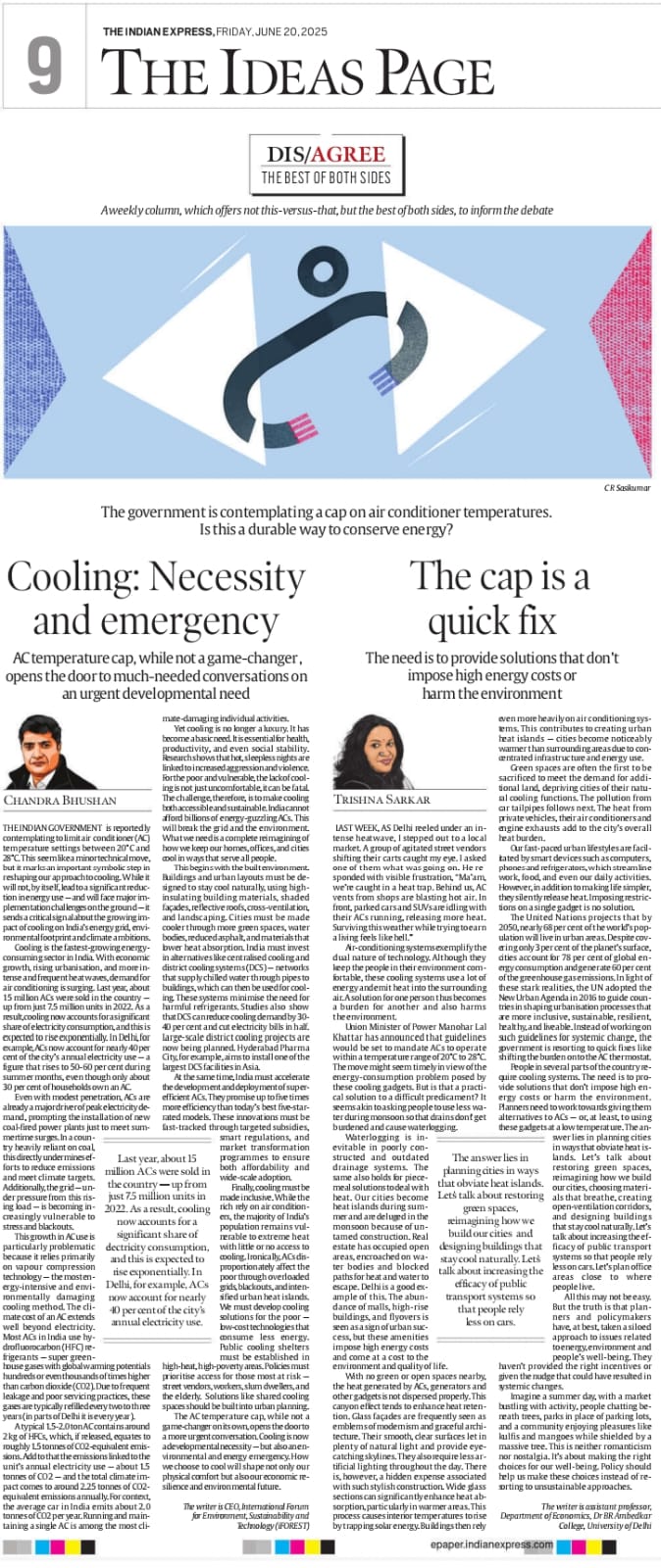This article appeared in The Indian Express
AC temperature cap, while not a game-changer, opens the door to much-needed conversations on an urgent developmental need
The Indian government is reportedly contemplating to limit air conditioner (AC) temperature settings between 20°C and 28°C. This seem like a minor technical move, but it marks an important symbolic step in reshaping our approach to cooling. While it will not, by itself, lead to a significant reduction in energy use — and will face major implementation challenges on the ground — it sends a critical signal about the growing impact of cooling on India’s energy grid, environmental footprint and climate ambitions.

Cooling is the fastest-growing energy-consuming sector in India. With economic growth, rising urbanisation, and more intense and frequent heat waves, demand for air conditioning is surging. Last year, about 15 million ACs were sold in the country — up from just 7.5 million units in 2022. As a result, cooling now accounts for a significant share of electricity consumption, and this is expected to rise exponentially. In Delhi, for example, ACs now account for nearly 40 per cent of the city’s annual electricity use — a figure that rises to 50-60 per cent during summer months, even though only about 30 per cent of households own an AC.
Even with modest penetration, ACs are already a major driver of peak electricity demand, prompting the installation of new coal-fired power plants just to meet summertime surges. In a country heavily reliant on coal, this directly undermines efforts to reduce emissions and meet climate targets. Additionally, the grid — under pressure from this rising load — is becoming increasingly vulnerable to stress and blackouts.
This growth in AC use is particularly problematic because it relies primarily on vapour compression technology — the most energy-intensive and environmentally damaging cooling method. The climate cost of an AC extends well beyond electricity. Most ACs in India use hydrofluorocarbon (HFC) refrigerants — super greenhouse gases with global warming potentials hundreds or even thousands of times higher than carbon dioxide (CO2). Due to frequent leakage and poor servicing practices, these gases are typically refilled every two to three years (in parts of Delhi it is every year).
A typical 1.5-2.0 ton AC contains around 2 kg of HFCs, which, if released, equates to roughly 1.5 tonnes of CO2-equivalent emissions. Add to that the emissions linked to the unit’s annual electricity use — about 1.5 tonnes of CO2 — and the total climate impact comes to around 2.25 tonnes of CO2-equivalent emissions annually. For context, the average car in India emits about 2.0 tonnes of CO2 per year. Running and maintaining a single AC is among the most climate-damaging individual activities.
Yet cooling is no longer a luxury. It has become a basic need. It is essential for health, productivity, and even social stability. Research shows that hot, sleepless nights are linked to increased aggression and violence. For the poor and vulnerable, the lack of cooling is not just uncomfortable, it can be fatal. The challenge, therefore, is to make cooling both accessible and sustainable. India cannot afford billions of energy-guzzling ACs. This will break the grid and the environment. What we need is a complete reimagining of how we keep our homes, offices, and cities cool in ways that serve all people.
This begins with the built environment. Buildings and urban layouts must be designed to stay cool naturally, using high-insulating building materials, shaded façades, reflective roofs, cross-ventilation, and landscaping. Cities must be made cooler through more green spaces, water bodies, reduced asphalt, and materials that lower heat absorption. India must invest in alternatives like centralised cooling and district cooling systems (DCS) — networks that supply chilled water through pipes to buildings, which can then be used for cooling. These systems minimise the need for harmful refrigerants. Studies also show that DCS can reduce cooling demand by 30-40 per cent and cut electricity bills in half. Large-scale district cooling projects are now being planned. Hyderabad Pharma City, for example, aims to install one of the largest DCS facilities in Asia.
At the same time, India must accelerate the development and deployment of super-efficient ACs. They promise up to five times more efficiency than today’s best five-star-rated models. These innovations must be fast-tracked through targeted subsidies, smart regulations, and market transformation programmes to ensure both affordability and wide-scale adoption.
Finally, cooling must be made inclusive. While the rich rely on air conditioners, the majority of India’s population remains vulnerable to extreme heat with little or no access to cooling. Ironically, ACs disproportionately affect the poor through overloaded grids, blackouts, and intensified urban heat islands. We must develop cooling solutions for the poor — low-cost technologies that consume less energy. Public cooling shelters must be established in high-heat, high-poverty areas. Policies must prioritise access for those most at risk — street vendors, workers, slum dwellers, and the elderly. Solutions like shared cooling spaces should be built into urban planning.
The AC temperature cap, while not a game-changer on its own, opens the door to a more urgent conversation. Cooling is now a developmental necessity — but also an environmental and energy emergency. How we choose to cool will shape not only our physical comfort but also our economic resilience and environmental future.
Chandra Bhushan is one of India’s foremost public policy experts and the founder-CEO of International Forum for Environment, Sustainability & Technology (iFOREST).
